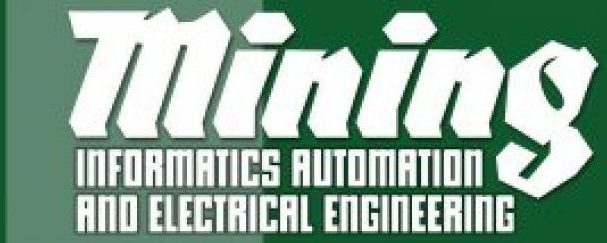ANDRZEJ FRĄCZEK
ENGINEERING PROJECT OF A MOBILE ROBOT WITH A METAL DETECTOR FOR LANDMINE DETECTION
This paper presents the design of a mobile tracked robot capable of moving in varied terrain. Its task is to detect metal objects, which is achieved by means of a metal detector placed on a manipulator with three degrees of freedom. The whole system is controlled from a phone using a dedicated application. For the mechanical parts, a mathematical model was created, which was used to carry out driver selection and other essential components. For the detector, a description of research carried out to select the coil of the sensory system is presented. In the part related to the control of the robot, the application and the process of testing by means of a station made on a prototype board is presented. Finally, the assembly of the entire robot is presented along with conclusions and directions for further research.
https://doi.org/10.7494/miag.2021.1.545.7
PAWEŁ KARELUS, KRYSTIAN SZOPA
DESIGN AND CONSTRUCTION OF A THREE-AXIS PICK AND PLACE MANIPULATOR
The article presents the design and implementation of a three-axis Pick and Place manipulator based on OpenPnP software. It is designed for the placement of SMD components on PCB boards. A ready-made frame was used for the project, which required the selection of appropriate motors and the design of the required components for the Z-axis, which were design in Solidworks software. A belt drive was used to construct the manipulator as well as pneumatic components for lifting the SMD parts. Appropriate cameras were also selected and configured along with lighting, allowing the software to automatically check the progress of the machine. The next step was to select the electronic components of the machine and configure them. Then OpenPnp software was configured and prepared for the automatic placement of SMD components.
https://doi.org/10.7494/miag.2021.1.545.25
ANETA NAPIERAJ, ALDONA URBANEK, MAREK BOROWSKI
FUTURE COMPETENCES IN MINING
(BASED ON SURVEYS, EVALUATIONS AND OPINIONS ON THE PROJECT SECTORAL QUALIFICATIONS FRAMEWORK FOR MINING)
One of the stages of work on the Sectoral Qualifications Framework for Mining (SQFM) was to verify its initial design as a result of quantitative research using questionnaires and qualitative research through in-depth interviews (IDI). Their main goal was to identify the opinions and attitudes of respondents related to the mining industry towards the implemented SQFM project. Both people working in mining plants and in other companies and units related to the mining sector were invited to take part in the project. The expected result of the conducted research was the collection of material allowing for the verification of the provisions in terms of the needs and expectations of employers as to the qualifications of the employed employees and the assessment of the legitimacy of the proposed solutions.
In designing the research, the use of qualitative and quantitative methods was assumed. This made it possible to triangulate the data – looking at the studied research problems from different perspectives, which was to influence the obtaining of empirical material allowing for the analysis of the discussed problems taking into account various points of view. As a result, the image of the needs in the area of increasing competences and the main deficits in the mining sector has crystallized.
https://doi.org/10.7494/miag.2021.1.545.50
BARTOSZ GÓRALCZYK WOJCIECH HORAK
DESIGN OF A MACHINE FOR TRENCHLESS PIPE REPLACEMENT USING THE STATIC CRACKING METHOD
Efforts to minimize surface disturbances during earthworks are an important aspect of modern civil engineering. These expectations are met by a number of technologies that make it possible to carry out such works using trenchless technologies. The static cracking method makes it possible to extend, modernize or renovate the existing underground infrastructure. The paper presents the de- sign of a device assigned for trenchless pipe replacement using the static cracking method. The developed device is characterized by the use of a new type of drive system with the use of articulated rods. In addition, the work proposes ways to solve the main issues in the design of this type of device.

